This easy Kimchi recipe is simple to make at home and takes only 30 minutes of hands-on time before Mother Nature takes over! Full of healthy, gut-healthy probiotics, this authentic kimchi is vegan-adaptable, gluten-free, and can be made as spicy or as mild as you like! Includes a video.
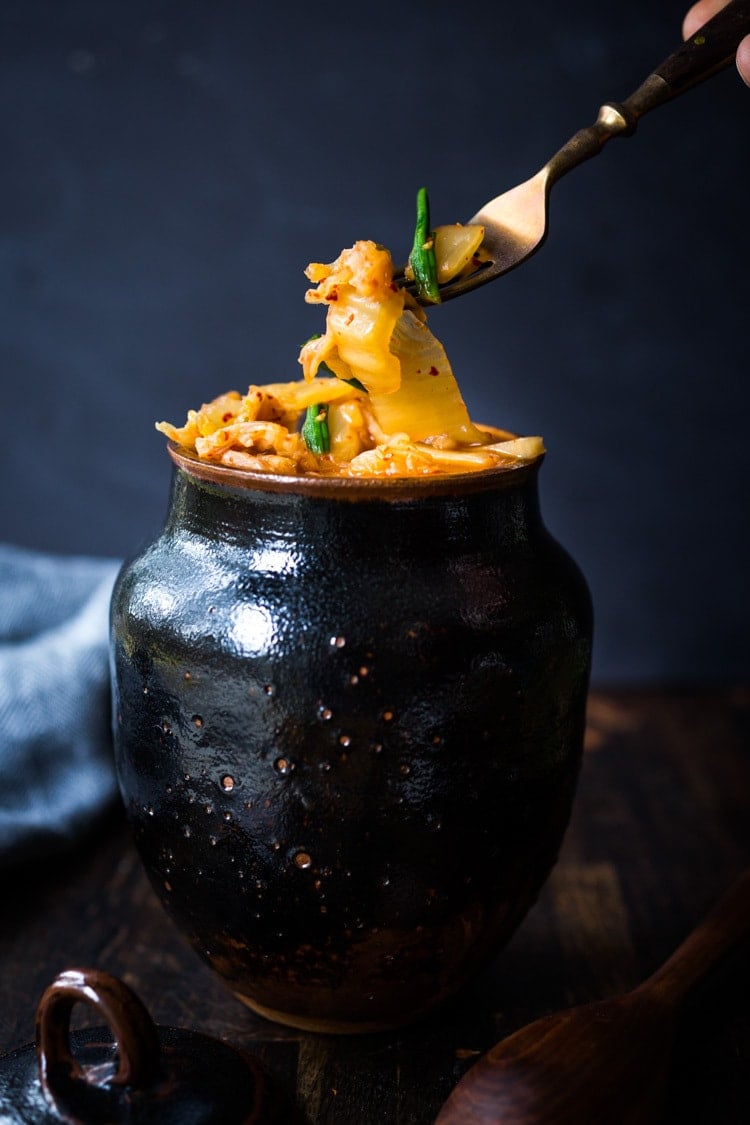
We are never in as much joy as when we are engaged in the well-being of others. ~ Adyashanti
Kimchi is essentially fermented cabbage -similar to sauerkraut in how it is made, but seasoned with Korean spices: garlic, fish sauce, ginger & Korean chilies. Kimchi is the heart and soul of Korean cooking, and delicious with so many things!
Want to know the best thing about Kimchi? Kimchi is alive! Full of living, healthy, good bacteria or probiotics that support the gut, boost immunity, energize the body, and aid digestion, it is believed to fight cancer, lower cholesterol, and regulate blood sugar.
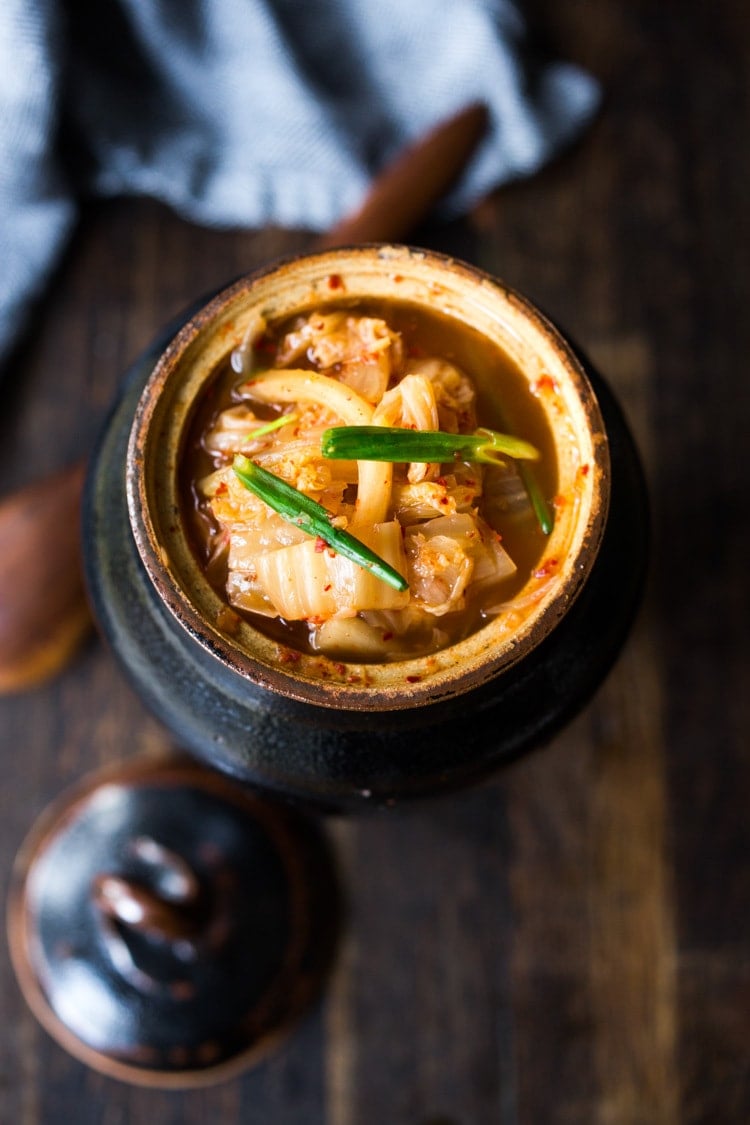
Why You’ll Love This Kimchi Recipe!
- Simple ingredients. Familiar, whole-food ingredients like cabbage, spices, optional fish sauce, salt, dried Korean chilies, and sugar are called for here. Nothing processed!
- Vegan-adaptable. This recipe calls for fish sauce but can easily be made vegan. You can also leave out the sugar if you prefer.
- Incredibly nutritious! Kimchi is full of gut-healthy probiotics (specifically lactobacillus bacteria) that support a diverse gut microbiome. It also boosts the immune system, energizes the body, lowers cholesterol, and regulates blood sugar- along with so many other benefits!
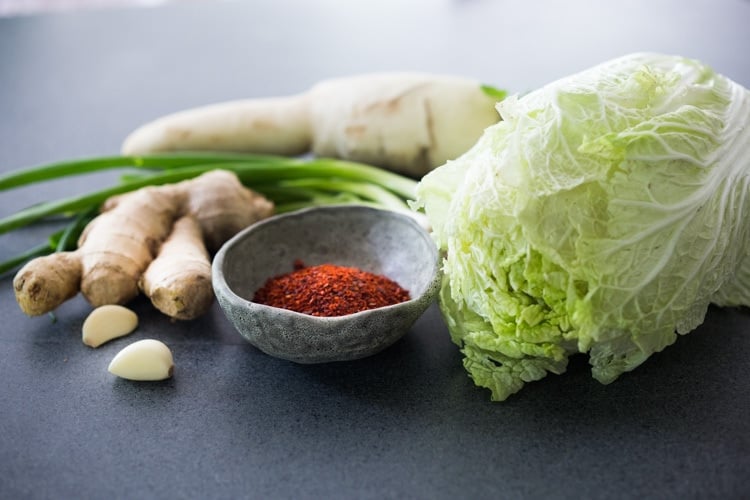
Kimchi Ingredients
- Napa Cabbage: This is the main ingredient and the heart of the recipe. Opt for organic or locally grown. Yes, you can substitute other cabbage, but Napa Cabbage is traditional.
- Fine Sea Salt– salt is key to fermenting, inhibiting bad bacteria growth while promoting good bacteria.
- Ginger: Adds a fragrant and subtly spicy taste.
- Garlic: Aromatic and pungent, garlic is key to enriching the flavor.
- Scallions (green onions): Brings in a bit of onion-like flavor, crunchy texture and color!
- Daikon: Subtly sweet and crunchy, daikon radish adds substance and texture.
- Fish Sauce, Shrimp paste, or Miso paste: Adds salt, umami, and depth of flavor. Shrimp paste is traditional, but fish sauce and miso (vegan option) both work too.
- Korean Chili Flakes: We use dried chili flakes (called Gochugaru)here for the purest, cleanest flavor(no preservatives, oils, or flavorings). Feel free to sub Gochujang paste if you prefer.
- Optional: Glutenous rice flour can be added to thicken.
- Equipment: An 8-cup mason jar and a fermentation weight are handy.
This easy kimchi recipe makes enough to fill a large two-quart jar (about 8 cups).
Kimchi Variations
Like so many things, there are so many variations to kimchi, and people have their own personal preferences. I just wanted to provide you with a starting point, and I’m sure you will adapt to your own tastes!
- Sugar is optional- some people add it, some don’t!
- Matchstick carrots would make a nice addition if you want more vegetables.
How to make Kimchi (Step-by-step Instructions)
*See the recipe card and video below!
Step one: Save 1-2 outer leaves of napa cabbage and place them in the fridge while you prep the recipe. (You will use these later). Using a cutting board, cut the napa cabbage into 1-inch cubes with a sharp knife.
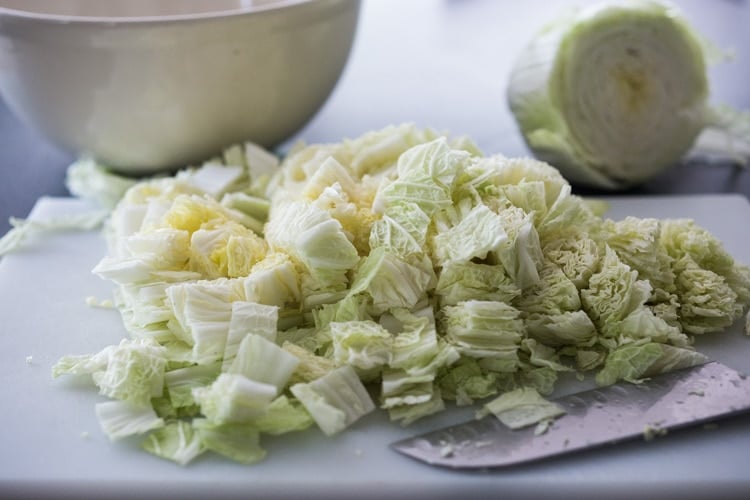
Step two: Place the chopped napa cabbage in a bowl and toss with 1/4 cup sea salt.
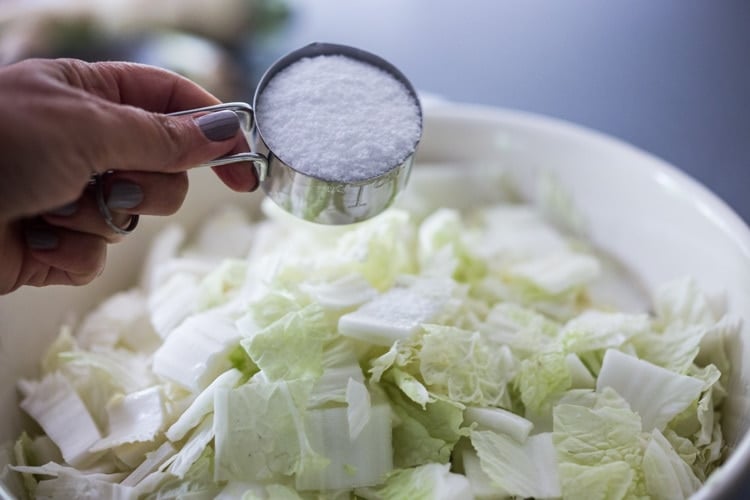
Step three: Fill the bowl with filtered water and stir, and soak the napa cabbage for 6-8 hours, stirring every couple hours.
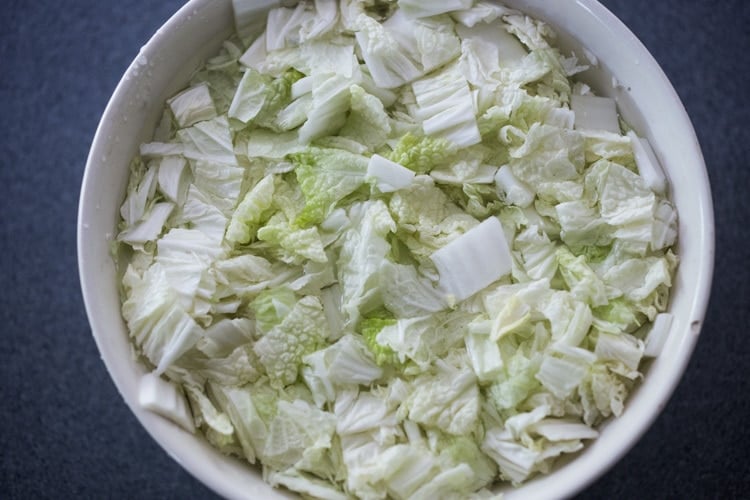
Place plate over the napa cabbage to keep it submerged.
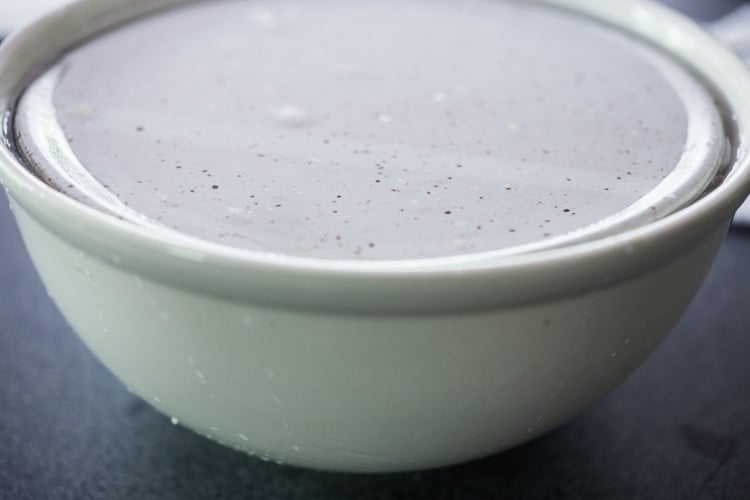
Step Four: After 6-8 hours, drain (making sure to save the brine) and rinse, pressing the liquid out.
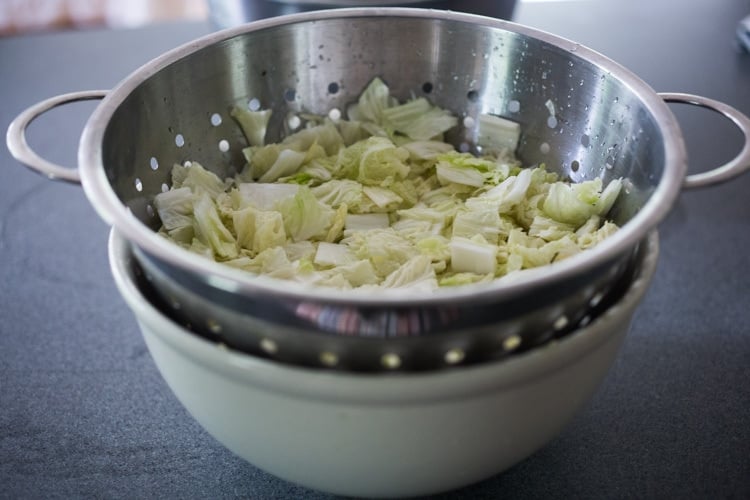
Step Five: Make the Kimchi Paste
As I stated earlier, I prefer to use Korean Chili Flakes called “Gochugaru” vs. the Korean fermented Chili Paste called “Gochujang”. Feel free to use Gochujang if you please. Totally up to you. Either way, you will make the paste below.
Many people ask if they can use regular old chili flakes- yes, but they are much spicier!!! Gochugaru is fruitier and less spicy, so you can use more and get more flavor. You could try subbing dried Arbol Chilies if you absolutely can’t get the Korean Chili flakes – or even use fresh red chilies to make the paste.
In a food processor, make a paste with garlic, ginger, shallot, Korean chili flakes (or Gochujang) and optional fish sauce (or miso) and sugar. If you want a mild version, use half the chili flakes. The fish sauce really adds a delicious complexity and depth, but you can, of course, keep it vegan with miso paste.
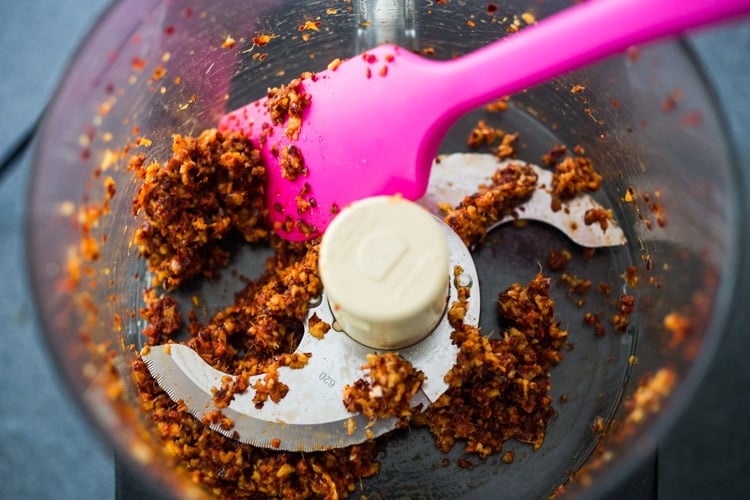
Step Six: Peel and cut the daikon radish (or carrots) into match sticks, about 2-3 inches long. Cut the scallions.
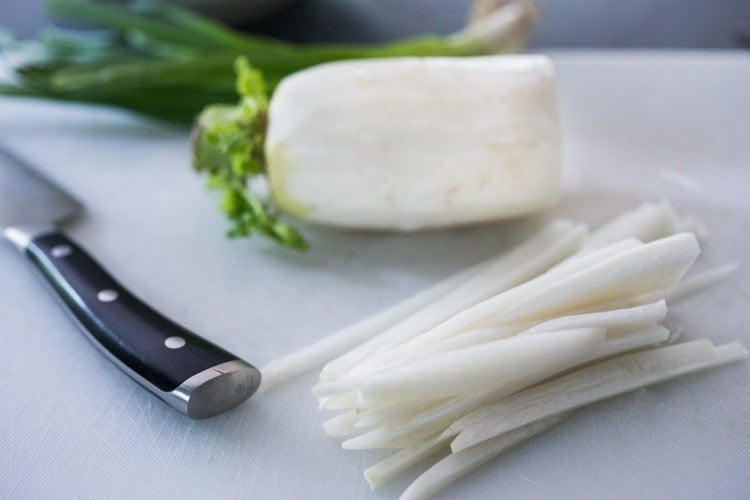
Step Seven: Cut the scallions into 1-2 inch pieces.
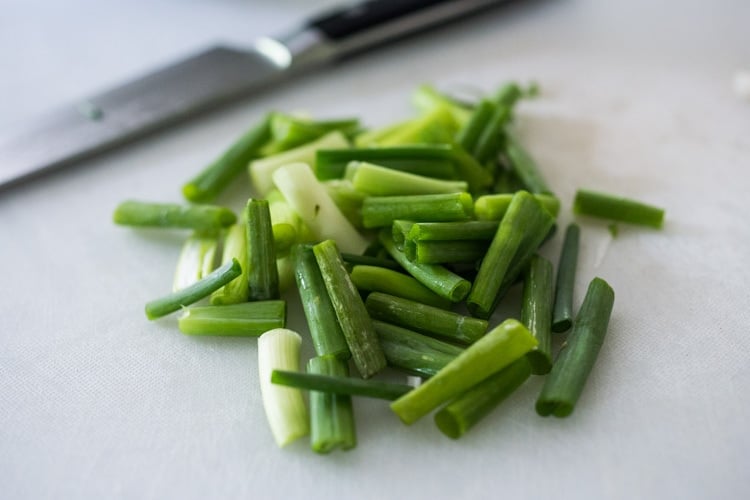
Step Eight: Combine the Kimchi. Place the drained cabbage along with the daikon, scallions and chili paste into the bowl. Massage the cabbage with gloved hands.
FYI: This is a very mild version shown below, so not very red in color, (2 tablespoons chili flakes). You can add more chili flakes if you want it spicier – I normally add 4-6 tablespoons.
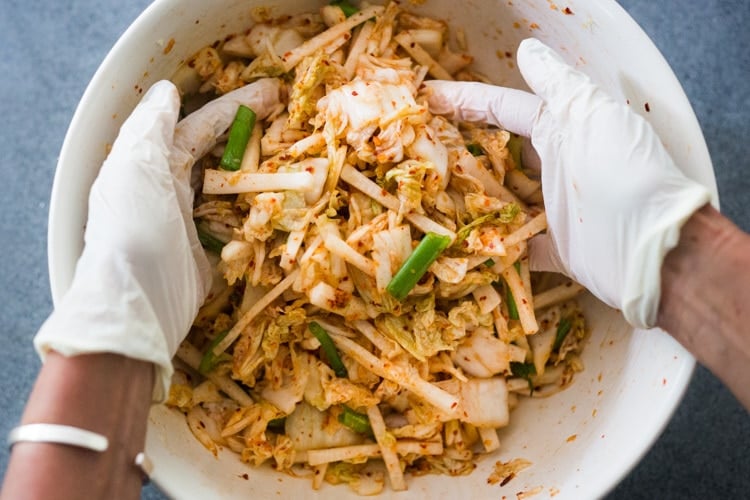
Step Nine: Pack the Kimchi.
Pack tightly into a large two-quart jar (half-gallon, 64 oz) or large crock. (Or use two, quart-sized mason jars.) You want a good two inches of space at the top to catch the flavorful liquid that will release.
TIP: I have had great success with this Fermentation Kit that has crystal weights that fit perfectly in a wide-mouth mason jar. It is so convenient for small-batch ferments. This fermentation kit includes the jars which is a great option too!
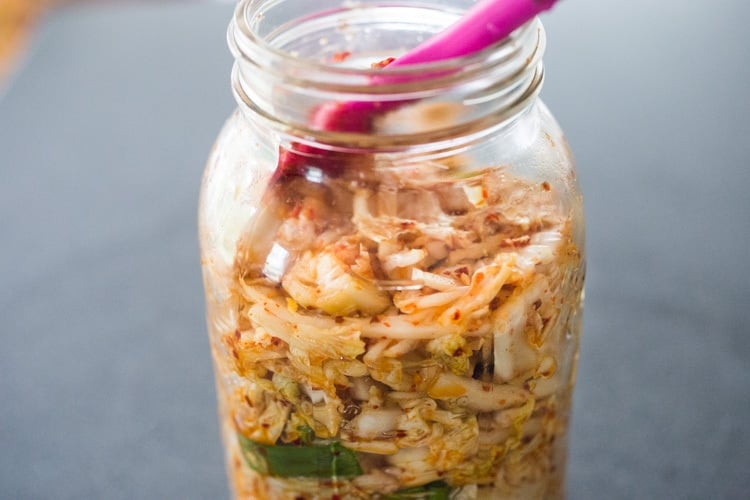
Cover with the cabbage leaf you saved in the fridge, and press down. Pour a little of the brine into the jar, just enough to cover the cabbage.
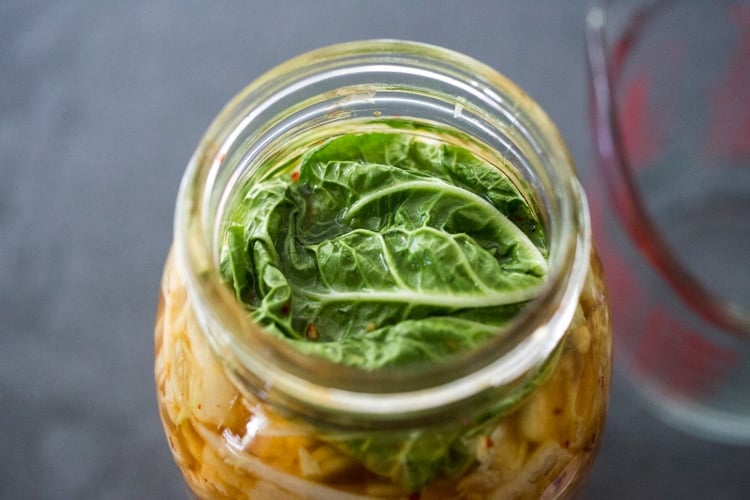
The cabbage leaf will help keep the chopped pieces of cabbage contained and submerged. Add a fermentation weight, pressing down to keep the cabbage leaf submerged under the brine. Anything that floats to the top and touches air can mold. So remove with a slotted spoon. Cover lightly with a lid (do not screw on tight) and place on a rimmed pan or bowl ( to collect any overflow).
Step Ten: Lacto-Fermentation
Set the jar somewhere dark and cool like the basement for 3-5 days. 60F-70F is ideal. Use a thermometer! A lower kitchen cabinet away from the stove or appliances can also be a cool spot. Fermentation happens faster in warmer climates and slows in cooler climates.
Check daily, pushing down the cabbage under the brine if need be and removing floaters. Remember, anything that touches air can mold.
After 2 days, the salt will have inhibited the bad bacteria enough to make more room for the good bacteria to feed on the cabbage and grow. As they “eat” the cabbage, they create gas and a tangy byproduct. This is how you know it is fermenting!
How do you know if kimchi is fermenting?
- After 3 days, tap the jar to see if any bubbles rise to the top; bubbles indicating that it is fermenting. If there is any overflow, this is also a good sign of fermentation.
- Smell, or taste the kimchi for tanginess. If it tastes sour or tangy, this is a sign of fermentation. If it just tastes salty, it is not fermented. Let it it sit a few more days.
- Continue to ferment for 2 to 3 more days. If you want it tangier or softer, ferment longer, and when satisfied, place it the fridge, keeping in mind it will continue to ferment and create lactic acid, albeit more slowly. It will develop more flavor and complexity over the next two weeks in the fridge, and the spice level will mellow with time!
FAQs
The ideal temperature for fermenting kimchi is 65 degrees. 65 F is perfect! The cooler it is, the slower it will take to ferment. The warmer, the faster. The longer you ferment the tangier and softer the kimchi will get. I prefer slightly crunchy kimchi, so ideally, 3-5 days at 65F is my favorite! Going too much over 70 degrees can actually have negative effects on the flavor.
If your kimchi is too watery for your taste, you can thicken it. To thicken kimchi, stir in a little glutenous rice powder. Some traditional recipes also use soybean powder.
Keep fermented kimchi in the refrigerator. Kimchi can not be made shelf-stable without killing the probiotics. Store in a 2-quart jar or crock with the lid on, pressing it down under the brine after each use. It will keep for months on end in the fridge when the kimchi is submerged below the brine….getting better and more flavorful with time!
Kimchi tastes sour, tangy, salty, spicy, and pungent! It’s similar to sauerkraut in that it is fermented cabbage, but kimchi is packed with flavor, umami and a little (or a lot) of heat! The fermentation process is what gives kimchi its sour flavor.
Because kimchi is naturally fermented, it is full of healthy bacteria, good for the gut and good for immunity. But besides being a healthy thing to incorporate into our diets, Kimchi adds so much flavor to things we are already making at home!
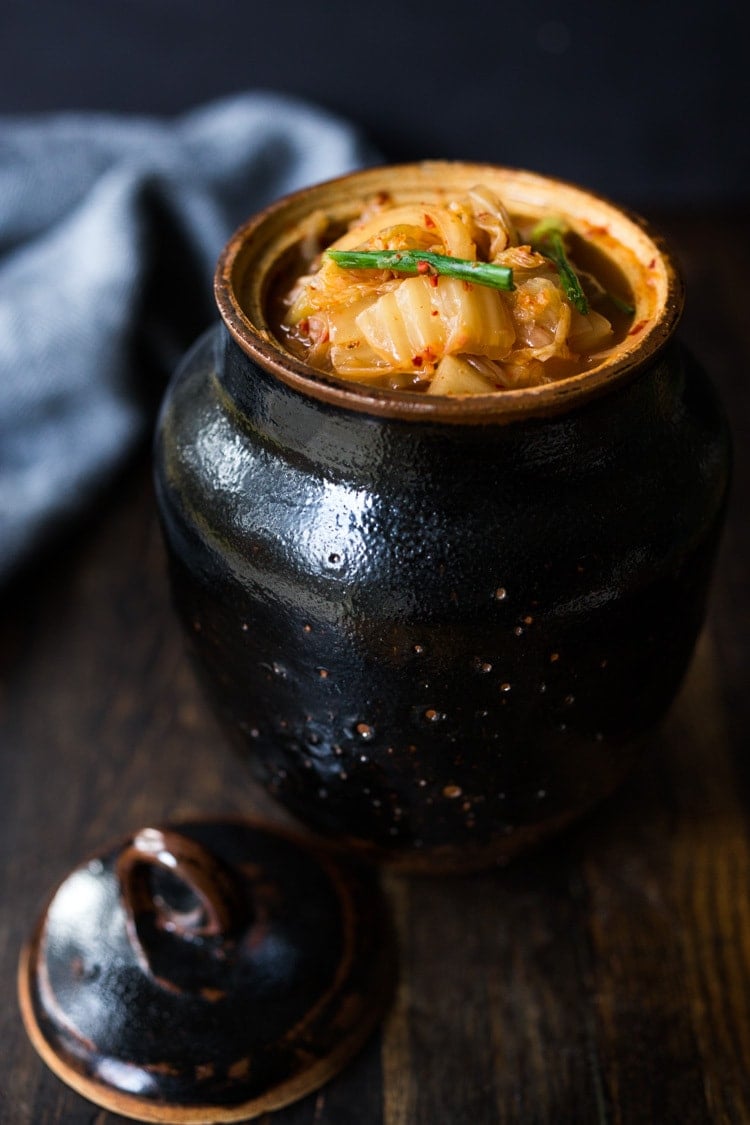
WAYS TO USE KIMCHI
We add napa cabbage kimchi to so many things! It is a huge flavor booster, and FULL of natural, gut-healing bacteria that support your microbiome, boost your mood, and bolster your immune system!
Here are a few of our favorite ways to use kimchi!
- Kimchi Fried Rice
- Kimchi Noodles
- Kimchi Burritos
- Kimchi Soup Recipe
- Seoul Bowl!
- On Buddha Bowls
- As a side dish with dinner, simply drizzled with toasted sesame oil and with a sprinkle of sesame seeds!
Probiotic Benefits of Fermented Foods!
There are so many reasons to consume fermented foods and probiotics daily, like this gut shot that contains strains of live probiotic cultures. Here are the benefits of consuming live active cultures:
- Improved Digestion: Probiotics can help maintain a healthy balance of gut bacteria, preventing dysbiosis or leaky gut. Probiotics aid in digestion and nutrient absorption. Read more.
- Enhanced Immunity: A healthy gut contributes to a strong immune system, and probiotics can help support this by promoting a balanced gut microbiome. Further information.
- Mental Health Support: Some studies suggest that probiotics may have a positive impact on mental health, potentially helping to reduce symptoms of anxiety and depression. Explore the study.
- Reduced Inflammation: Certain probiotic strains have been linked to a reduction in inflammation in the body, which may benefit overall health. Read this.
- Metabolic Health. Adding fermented foods to the diet can play a role in preventing and managing metabolic conditions, such as obesity and diabetes. The metabolites produced during fermentation can help regulate appetite and improve insulin sensitivity. Some fermented foods have been associated with better weight management.
- Cardiovascular Health. The bioactive peptides produced during the fermentation process have been recognized for their role in cardiovascular health. These substances can lower blood pressure and have anti-thrombotic properties, which are important in the prevention of heart disease. Check out the research.
More Favorite Fermented Foods!
Enjoy the process of making Kimchi! Please ⭐️ rate the recipe (always appreciated) and tell us how it goes in the comments below.
On the homefront: Many years ago now, we catered a Korean wedding. I remember meeting with the bride and groom and listening very carefully about the importance of the kimchi being served. It had to be “just right”.
Truth be told I was nervous, I had never made it back then, but the bride’s mother was kind enough to send me her personal kimchi recipe and thankfully I had time to practice it a few times before the big day.
In the end, they were happy. And wherever they are now, I hope they are still. I’ve never counted the number of weddings we’ve catered, but every so often, a couple pops into my mind, most often when I’m cooking, and I can’t help but give them a little nod and wish them well.
xoxo
How to make Kimchi | step-by-step video
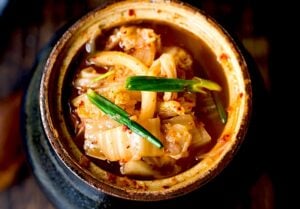
How to make Kimchi
- Prep Time: 30 minutes
- Cook Time: 4 days
- Total Time: 72 hours 30 minutes
- Yield: 8 cups 1x
- Category: fermented, sides, preserved
- Method: fermented
- Cuisine: Korean
- Diet: Vegan
Description
This easy Kimchi recipe is simple to make and takes only 30 minutes of hands-on time before Mother Nature takes over! Full of healthy, gut-healthy probiotics, this authentic kimchi is vegan-adaptable, gluten-free, and can be made as spicy or as mild as you like! Includes a video.
Ingredients
- 2 pounds napa cabbage, (large napa cabbage)
- 1/4 cup sea salt (60 grams)
- 2 cups daikon radish, cut into matchstick strips (optional, or use carrots)
- 1 bunch scallions, trimmed and cut into 1-inch pieces
- 1 tablespoon fresh ginger, sliced ( 2-3 disks, peels ok)
- 6 cloves garlic, whole
- 1 shallot, quartered (optional)
- 2–6 tablespoons Korean-style red pepper flakes (gochugaru) or sub gochujang – see notes!
- 2 tablespoons fish sauce (or use vegan fish sauce, shrimp paste, miso paste, or soy sauce), more to taste
- 2 teaspoons sugar ( or an alternative like honey, brown rice syrup)
- OPTIONAL:1 tablespoon glutenous rice powder (see notes)
Instructions
- SALT THE CABBAGE (6-8 hours): *Reserve 1-2 outer leaves of the napa cabbage and refrigerate for later use. Core and cut the remaining cabbage into 1-inch pieces and place in a large bowl with the salt and toss well. Add enough cool water to cover the cabbage and stir until salt is dissolved. Keep the cabbage submerged with a plate over the bowl and let this stand at room temperature 6-8 hours (giving a stir midway through if possible) or overnight.
- Drain the cabbage, saving the brine. Rinse the cabbage (not excessively, just a little quick rinse), drain, squeeze out any excess water, or blot with paper towels, and place it back in the bowl, adding the daikon radish and scallions.
- Make the PASTE: Place the ginger, garlic, shallot, red pepper flakes, fish sauce (or alternatives) and sugar in your food processor. Add optional rice powder (see notes!) Process until well combined, pulsing, until it becomes a thick paste.
- MASSAGE: Scoop the paste over the cabbage and using tongs or gloves, mix and massage the vegetables and the red pepper mixture together really well, until well coated.
- PACK the cabbage into a large, two-quart jar (or two, quart jars) or a crock, leaving 1-2 inches room at the top for juices to release. Add a little of the reserved brine to just cover the vegetables, pressing them down a bit ( so they are submerged) Place the whole cabbage leaf over top, pressing down- this should help keep the kimchi submerged under the brine. You can also use a fermentation weight placed over top of the whole leaf to keep it submerged. Or a small zip lock filled with water. Basically anything that touches air may mold – but no worries if this happens (see notes) it is not ruined.
- FERMENT (3-4 days) Cover loosely with a lid (allowing air to escape) and place the jar in a baking dish (or big bowl) to collect any juices that may escape. (The idea though, is to keep as much of the flavorful juice in the jar, so don’t overfill.) Leave this somewhere dark and cool (55F-65F is ideal) for 3 days. A basement or lower cooler cabinet in the pantry or kitchen away from appliances works best.
- EVENING OF DAY 3: Check for fermentation action or bubbles. Tap the jar and see if tiny bubbles rise to the top. Check for overflow (which also indicates fermentation). If you see bubbles, it is ready to store in the refrigerator where it will continue to ferment and develop more flavor slowly. For a softer tangier kimchi, you can continue to ferment for 3 more days or longer. If no action, give it another day or two. If you don’t see bubbles when tapping the jar, it just may need a couple more days- especially in cooler climates. Be patient. See the troubleshooting section below.
- REFRIGERATE: After you see bubbles (usually 3-5 days) the kimchi is ready, but it won’t achieve its full flavor and complexity, until about 2 weeks (in the fridge) slowly fermenting. The longer you ferment, the more complex and tangy the taste. If you like a fizzy brine, tighten the lid, burping every week or so. If you don’t want to think about it, give the lid one loose twist, so it’s on there, but gases can escape.
- Maintenance: This will keep for months on end in the fridge (as long as it is submerged in the brine) and will continue to ferment very slowly, getting more and more flavorful. Feel free to remove the cabbage leaf and just press kimchi down under the brine, after each use. ( See notes for adding more brine.)
- SERVE: Serve it as side dish: scoop it out using a slotted spoon, place in a small bowl, drizzle with sesame oil , toasted sesame seeds, and fresh scallions. Or Use it in Kimchi Fried Rice, Kimchi Burritos, Seoul Bowls, Kimchi Soup!
Notes
For milder kimchi, start with 2 tablespoons Korean chili flakes ( you can always stir in more). I like a spicy version with 6 tablespoons. 4 tablespoons is medium spicy.
If substituting with gochujang paste, add 2-6 tablespoons. You can always start conservatively and add more to taste after fermentation.
If you like your kimchi, thick, and less watery, you can use sweet glutenous rice powder to thicken. This is not the same as rice flour! Cook 1 tablespoon glutenous rice powder with ½ cup water, in a small pot over medium heat, stirring constantly until it boils. Let cool, still whisking occasionally. Add to the chili paste in the food processor. Continue with recipe.
BRINE If you need or want to add more salt brine to the kimchi, to keep it submerged, mix water and salt at this ratio: 1 cup water and 1 1/4 teaspoon fine sea salt. Stir it together first, pour over the kimchi.
TROUBLESHOOTING:
- MOLD If your cabbage leaf that is holding the kimchi down, happens to mold, just remove it, wipe out the rim of the jar as best you can, and replace it with a fresh one. Basically, if cabbage touches air here, it will mold, so after each use, press the kimchi down under the brine.
- NO BUBBLES: Check the temp of the kimchi using a kitchen thermometer. Ideally, you want this between 50-70F. 60-65 is best.
Nutrition
- Serving Size: ¼ cup
- Calories: 20
- Sugar: 1.6 g
- Sodium: 822.5 mg
- Fat: 0.2 g
- Saturated Fat: 0 g
- Carbohydrates: 3.9 g
- Fiber: 0.4 g
- Protein: 1.3 g
- Cholesterol: 0 mg
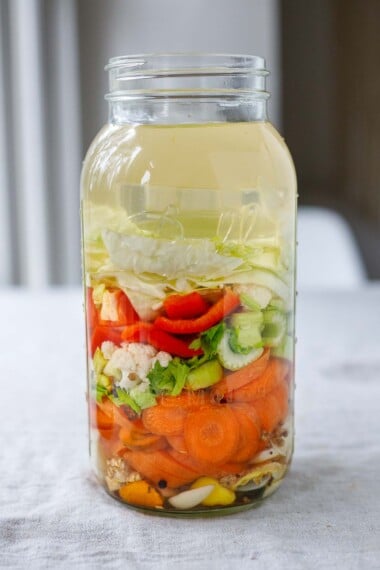
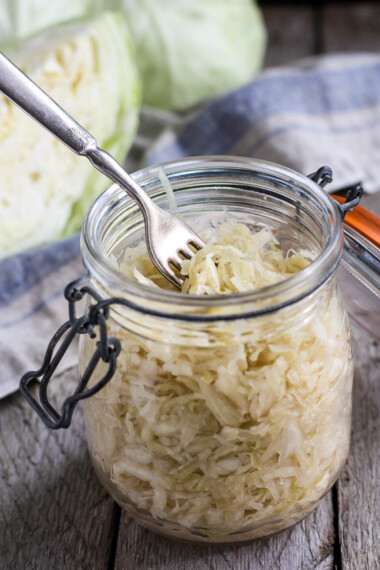
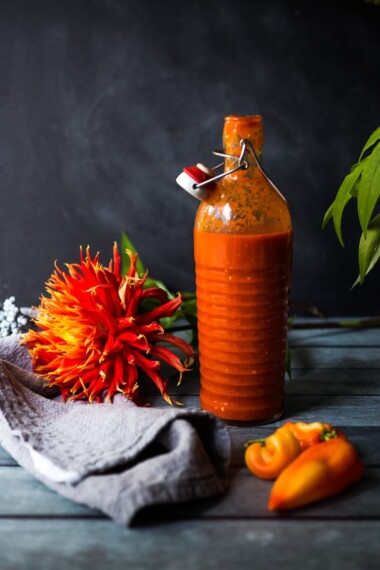
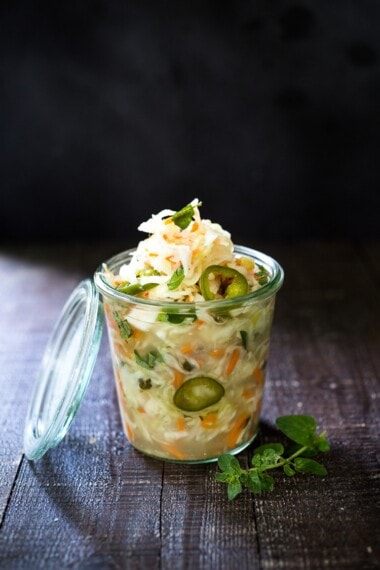
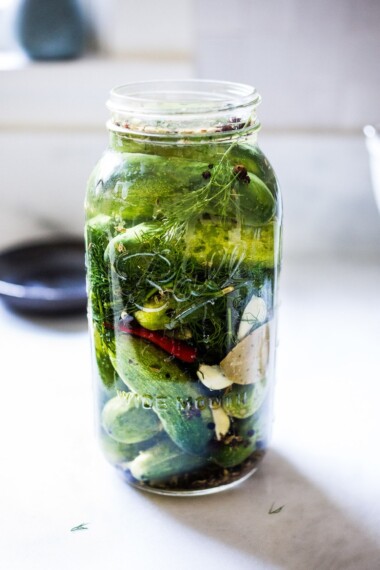
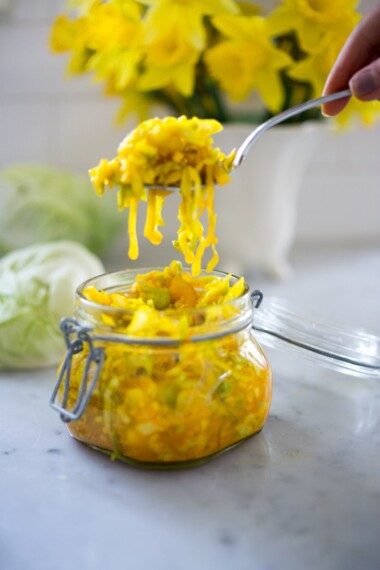
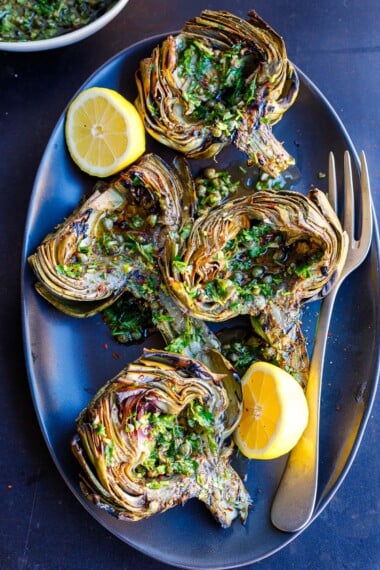
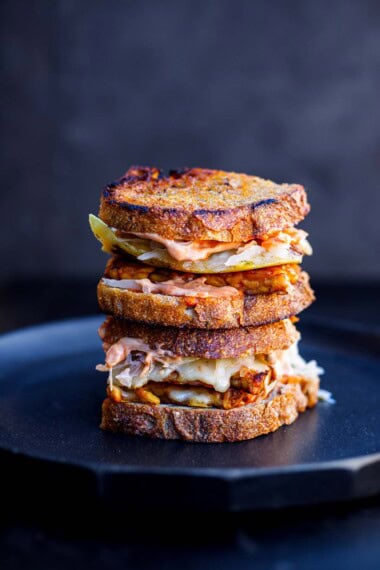
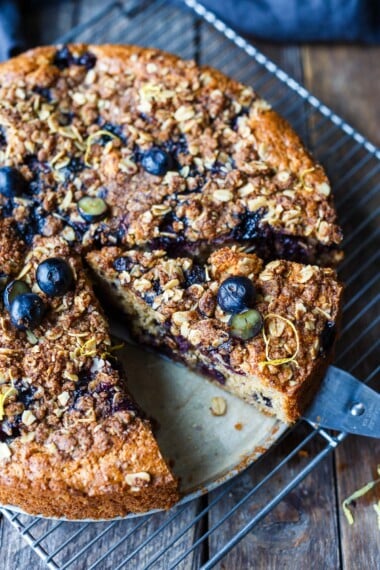
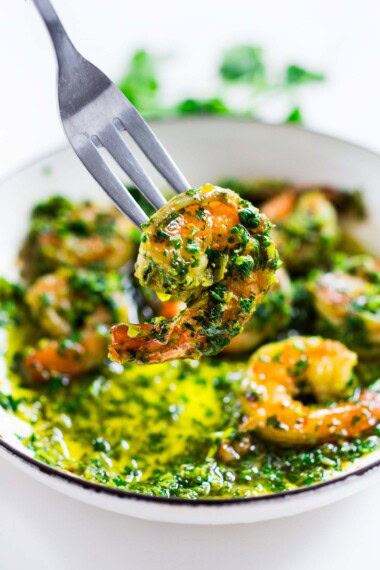
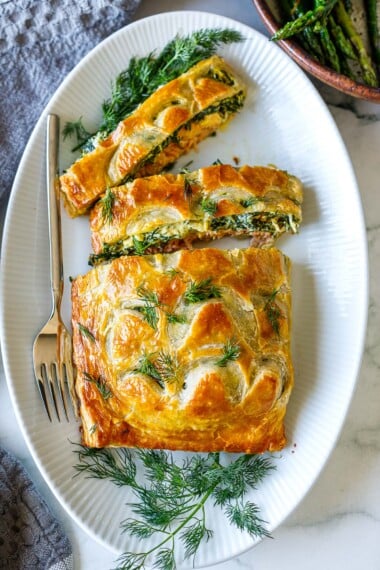
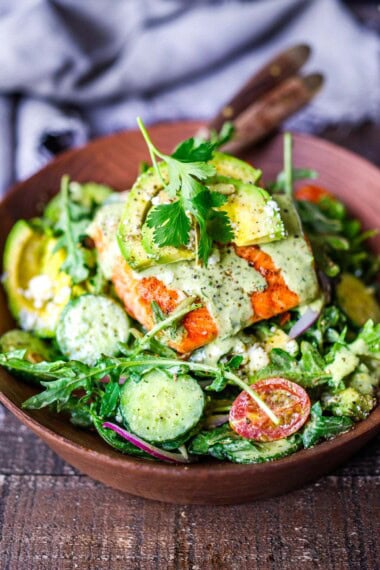
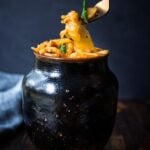
This looks amazing and I can’t wait to try it. I’m wondering if you can reuse the brine, though?
Some people do add some of the old brine to the new brine. You can also use brine in cooking- super flavorful added to soups and stews.
I have just made this, and put it in the fridge after three days. I can see some bubbles! However, I didn’t know what to weight the cabbage leaf in my widemouth mason jar with (I used half a recipe), so I used a half cup mason jar with the lid on and water in it. I rested the widemouth lid gently on top of the big jar while it fermented. I am wondering if the metal in the small jar ring could have had any impact? It wasn’t in direct contact with the brine when I put it in but might have settled. It tastes a little strange, but I am tasting it after brushing my teeth. 😀 What do you think?
Hmmm. Shoot. Yes, yes could be affected if the lid was soaking in the brine. You don’t really want metal soaking in the brine because the acid from the ferment can break down the metal- leaching it into the ferment. I would taste it again, if it tastes metallic, I personally would not consume it. Sorry to say. Maybe also google the metal content of the lid- if it is stainless, I think better than aluminum.
Hi
I made two big 2 litre jars with this recipe but noticed they’re both really watery. Is it okay to add the sweet glutinous rice paste now? Can i tip the contents out or add it to the top and try to mix it in or do you not recommend it? Does it have to be before you start fermenting the kimchi? It’s already started to ferment it’s currently day2/3
I think it should be fine to add now. Whichever way is easier to incorporate.
Really enjoyed making this ! I’m now at the end of day 3 and it’s bubbling nicely. I have a question: at what stage should I decant into smaller jars ? I get that it’s not necessary to do so, but it would be more convenient. Thanks !
When it is tastes perfect to you, then decant and refrigerate. The smaller jars are definitely more convenient!
I live in a very warm environment and don’t have a cool space in my home. Do you think I could put the crock in the refrigerator right away and maybe leave it in there longer?
Hey Austin- I’m not sure if that would work – or how long it would take. I would just put in a lower area of your coolest room. Check after 24 hours- then every 12 hours and as soon as you see bubbles put it in the fridge?
I just made this recipe and have to say the results are fantastic! This was my first time making kimchi, and I’m glad I used your recipe. I like things spicy, and used 4 Tbsp.of gochugaru – there was a nice heat to it, but next time I will add a bit more. I think I will add some shredded carrots next time, and cut back a bit on the ginger. Today is just day 4, so looking forward to seeing how the taste evolves over time. Thanks again!
Awesome Tim, it is so adaptable and love that you are playing around with it and adapting to your tastes!
After a Vietnamese student we hosted had bought kimchi I thought I’d try making it. Found your recipe and a year later I’m now trying to grow my own Napa cabbage from seed to make kimchi. Great kimchi for on top of meat patties in hamburgers and our Japanese student puts it in his noodles. Thank you for sharing your recipe.❤️
Love this Carol! ❤️
Hi
I love your kimchi recipe! Thank you. I have recently moved and don’t have my equipment that I had back home. Is it ok to soak cabbage in a plastic bowl and then put the finished product into a 5qrt Fermentation & Storage Container for Kimchi? There maybe a lot of space between kimchi and the top of container.
Thanks
Yes, that should be fine-just weight the kimchi down under the brine.
Hi again. Thank you. I didn’t think of that. I put a bag filled with water on top, then the lid. I left the plug open on the lid for it to breathe, and then put the 2nd top on loose too. Fingers crossed.
Hello! I love your website. Delicious healthful recipes! I am trying your kimchi recipe for the first time. I could only find gochugaru coarse(-ish) powder, not flakes. Any suggestions of how much of the powder to use in place of the 2-6 tablespoons of flakes? (We do like our spice!) Thanks
Hi Paula- I would go a little lighter. If you like spicy maybe go with 3 tablespoons, half that, for mild. You can always add more. 😉
Thanks, Sylvia. After packing the jars, I tasted the remains in the bowl. It’s just right!
Awesome Paula!
Thanks, Sylvia. I used 3 tablespoons, as you recommended. After packing the jars, I sampled the remains in the bowl–perfect!
Great taste, and easy to make. I put my jars near the furnace (AC running) in the basement, where it is a nice cool 67 degrees. I also found these to keep everything submerged: “Easy Grip Fermentation Weight- 4 Pack of Glass Weights for Wide Mouth Mason Jars” . They are inexpensive, and fit perfectly in the straight sided 24 oz jars, (will also work in any wide mouth jar). Thanks.
I use those too – thanks, Joseph! You have been busy in the kitchen- love it!
I encourage you to do your own research about msg. The idea that it is bad for you comes from racism against Chinese people and food, so your suggestion that you avoided an ingredient because it contains msg perpetuates that myth and racist ideas about Chinese food.
I actually have done research. This has nothing to do with racism, it has to do with headaches. I never said MSG was “bad”, only that it can cause headaches in some people.
Hi Sylvia; your note on MSG rings bells with me. I have found that items containing MSG will result in “disruptive dreams and elevated body temperature” at night. It took me years to isolate the problem (I’m over 75 now) and love all types of foods. Naturally occurring seems “ok” but added in is rough!
Yes, it really can affect some people. Glad you figured it out. 😉
No.
#1. It’s a chemical we can live without.
#2. High in sodium. Bad for persons with hypertension or liver issues.
Do I need a fermenting kit/jar to make this? Or is a normal jar fine?
Yes, Anna, you can use a normal jar (half gallon sized).
The recipe calls for 2lbs of cabbage. Is this before or after coring and removing outer leaves and tough bits? I ask because in the past I have only had a very small cabbage. I used the same amount of all the other ingredients and it was superb. This time I had 2lbs prepared cabbage and it was a bit weak.
This is before. 🙂
I enjoy regular head cabbage. Can it be used in place of Napa cabbage?
Give it a try Eric! I think it would be delicious. Fermenting is really adaptable and forgiving!
Hi! You mentioned that you can sub the gochugaru with Gochujang, but i can’t find the notes regarding this. Can you give advice on how should I do this?
Hi Alex- sorry about that. I added a note at the bottom- just use the same amount- 2-6 tablespoons, depending on how spicy you want it!
You mentioned temps over 70 could be bad for it, besides in the winter time (which is short lived where I’m at), our house is routinely over 77 (it hovers about 68-70 during the winter). Do you have any suggestions on what I should do?
I think you should be fine…I’d just place in a lower cupboard ( heat rises) somewhere out of direct light.
If you open up the jar while it’s fermenting does it interrupt the fermenting process?
Not at all. 🙂
It was my first attempt at Making Kimchi, the instructions were clear and easy to follow . I enjoy Kimchi when we eat out , I will be enjoying it more often now that I can make it at home
Congrats John! Glad you gave this a go!
Excellent recipe! I have made homemade sauerkraut but was scared to make kimchi. Your recipe was easy to follow and the results are better than storebought. Thank you!
Awesome Aimee! glad you gave it a go!
Thanks for the recipe. I haven’t tried it yet but I plan to soon. FYI, the fermentation kit you linked to does NOT include the jars.
Yes just the weights and lids. I’ll see if I can find one with the jars…
I doubled the recipe and it filled one of the large jars (from the second fermentation kit) with a small bit left over. If someone expects to fill both of those jars, they should make x3 or x4 of this recipe. This was my first time making kimchi, I read many recipes, but followed this one and I am confident that I made great kimchi. The one question that I have is, when my 3 day fermentation was complete, I did find many bubbles or small air pockets. I pressed down on the weight which made nearly all of those bubbles rise. Did I mess anything up by doing this? Should I not have done this? Thanks for the awesome recipe!
You did exactly right Jeremiah! Sounds good!
Just wondering ,is this also a breakfast dish?
I suppose it could be added as a side to savory breakfast things?
I didn’t see the note about the glutinous rice flour…I just added it in with the paste without cooking it. Is it ruined?
I’m not sure! It might still work Eliane- I honestly don’t know. If it is already in there, don’t toss it, just see what happens, and will you let me know? I will update recipe to make it more clear.
It worked fine! The paste was very crumbly because of the lack of water, but as the kimchi fermented, the cabbage produced enough water to make a brine. Very delicious, next time I’ll make sure to cook the glutinous rice flour though!
Great to hear!
Great tasting recipe everyone I give it to loves it third batch stuff is great
Awesome, thanks Jim!
What if I don’t have a food processor?
Just chop /mash everything very finely!
Thank you this was an easy recipe. Did go to the Asian Market & bought Korean chili pepper flakes. Really good. I am a Spice Girl! 2 quarts gone working on the 3rd one. No left😫
Awesome Lynn!